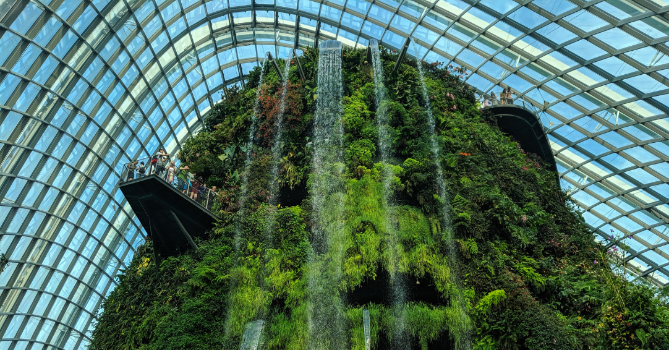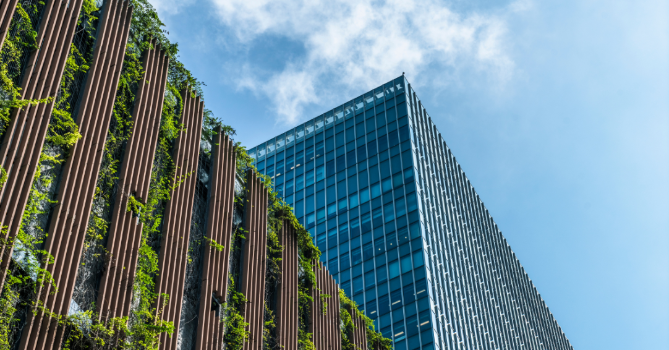.png)
Green Buildings: Pioneering Sustainable Living and Working Spaces
Green buildings are essential in today's world, where environmental sustainability is more crucial than ever. These structures are designed with care to minimize their impact on our planet, using less water, energy, and natural resources compared to standard buildings. They also provide healthier living spaces, improving air and light quality, which enhances the well-being of everyone who uses them. This approach not only benefits the environment by reducing pollution and conserving resources but also offers financial savings through lower operating costs. Embracing green buildings isn't just about adopting new technologies; it's about changing our mindset towards construction and our responsibility towards the earth. As we delve into the world of green buildings, we'll uncover how they are pivotal in driving us towards a more sustainable and healthier future.
Green building certifications are crucial tools that ensure buildings meet specific sustainability standards, guiding construction projects towards more eco-friendly practices. These certifications cover various aspects of sustainability, including energy use, water conservation, material selection, and the overall environmental impact of buildings.
One of the most recognized certifications is LEED (Leadership in Energy and Environmental Design). Developed by the U.S. Green Building Council, LEED is an internationally acclaimed system that provides a framework for healthy, highly efficient, and cost-saving green buildings. Buildings are rated on levels like Certified, Silver, Gold, and Platinum, depending on their compliance with different sustainability criteria.
Another significant certification is the Green Globes system, which offers a flexible, user-friendly approach to environmental assessment and certification. Unlike LEED, Green Globes is praised for its adaptability to a wide range of building types and its personalized assessment process. It evaluates areas such as energy, water, resources, emissions, and indoor environment.
BREEAM, the Building Research Establishment Environmental Assessment Method, is another pioneering certification, widely used in Europe. It sets the standard for best practices in sustainable building design, construction, and operation and has become a symbol of commitment to the environment and sustainability.
These certifications not only push for higher environmental standards but also contribute to a building’s market value, making them more attractive to investors and tenants who prioritize sustainability. They also help in mitigating the operational costs of buildings by ensuring efficient use of resources which can lead to significant savings over time.
By adhering to these certifications, developers and architects not only contribute to environmental conservation but also enhance the livability and appeal of their buildings, proving that sustainability and profitability can go hand in hand.
The global push towards sustainable construction is gaining momentum, driven by a growing awareness of environmental issues and the urgent need to address climate change. Green buildings are at the forefront of this movement, with various regions around the world adopting and promoting eco-friendly building practices.

In North America, certifications like LEED have set high standards, pushing the market towards more sustainable construction methods. Europe follows closely with BREEAM, encouraging innovative approaches to building that minimize environmental impacts. Similarly, the Asia-Pacific region is witnessing a surge in green building, propelled by rapid urbanization and the need for sustainable infrastructure.
Countries are increasingly recognizing the economic benefits of green buildings, such as reduced energy costs and increased property values. For instance, in Australia, green-certified office buildings have been shown to command higher rents and lower vacancy rates compared to non-certified buildings. Moreover, governments are stepping up by integrating green standards into building codes and offering incentives for sustainable practices.
The impact of these global trends is substantial. By the end of 2021, billions of square meters of building space worldwide had been certified under green building standards, highlighting a significant shift towards sustainability in the construction sector. This shift is not just about environmental benefits; it also improves the quality of life for building occupants by providing healthier living and working environments.
As these trends continue to evolve, the role of green buildings in shaping our cities' futures becomes increasingly central, heralding a new era of sustainable urban development.
Green buildings make a profound impact, not only on our environment but also on our economy and social well-being. By focusing on energy efficiency, these buildings significantly reduce carbon footprints, helping to combat climate change. For instance, green buildings typically use less energy and water, which directly translates to lower utility bills and operational costs.
Economically, the value of green buildings is evident in the real estate market. Properties with sustainable certifications often enjoy higher valuation rates and attract tenants more quickly than traditional buildings, resulting in lower vacancy rates and higher rental income. This appeal is partly because more consumers and businesses are becoming environmentally conscious and prefer buildings that align with their values.
Socially, green buildings contribute to healthier environments for their occupants. Improved indoor air quality and natural light are just a couple of the health benefits that enhance the well-being and productivity of those who live and work in these spaces. Studies have shown that employees in green-certified buildings report higher levels of satisfaction and productivity.
Moreover, green buildings play a crucial role in water conservation. They often incorporate rainwater harvesting systems, efficient plumbing fixtures, and water recycling processes, which reduce the overall demand for potable water and minimize the strain on local water resources.

Overall, the benefits of green buildings are comprehensive, addressing multiple layers of sustainability. By reducing environmental impact, enhancing economic returns, and improving health and comfort, green buildings are pivotal in driving sustainable development forward. This holistic approach not only benefits current generations but also sets a sustainable precedent for the future of construction and urban planning.
While green buildings represent a significant step toward sustainability, they also face several challenges. The initial costs of green construction can be higher than traditional methods, primarily due to the premium prices of sustainable materials and advanced technologies required. This financial barrier often discourages developers and investors who are focused on immediate costs rather than long-term savings.
Another challenge lies in the regulatory landscape. Inconsistencies and a lack of standardization in green building regulations can create confusion and deter adoption. Different countries and regions have varied standards and certifications, which can complicate the process for global developers and hinder the broader acceptance of green building practices.
Despite these hurdles, the future outlook for green buildings is optimistic. Technological advancements are continually reducing the cost of sustainable materials and renewable energy systems, making green buildings more accessible and affordable. Additionally, there is a growing trend towards mandating more stringent environmental standards in building codes, which could normalize green practices and level the playing field.
Moreover, public awareness and demand for sustainable living spaces are increasing. As more people recognize the benefits of green buildings—not just for the environment but also for health and economic savings—market demand is expected to rise, further driving the development of green technologies and materials.
Looking forward, the integration of smart technology with green building practices is likely to become more prevalent. Smart systems that optimize energy and water use can enhance the efficiency of green buildings and provide real-time data to improve operation and maintenance. The future of green building also points towards more holistic approaches like the Living Building Challenge, which not only focuses on environmental impact but also promotes beauty, equity, and a positive human experience within the built environment. These innovations and shifts in both consumer preference and policy indicate that green buildings will be central to the future of sustainable urban development.
As we've explored the world of green buildings, it's clear that they are more than just an environmental commitment—they are a multifaceted solution that benefits our planet, economies, and personal health. Green buildings not only help in reducing the environmental footprint but also offer economic advantages through energy savings and higher property values. The health benefits for occupants are undeniable, making these spaces more desirable to live and work in. Despite facing challenges such as initial costs and regulatory hurdles, the future is promising. With advancing technology, growing public awareness, and increasingly stringent environmental standards, green buildings are set to play a pivotal role in our sustainable future. As we continue to innovate and advocate for green practices, these structures will become standard, shaping a healthier, more sustainable world for generations to come.
Embrace a greener future by advocating for and investing in green buildings in your community. Learn more about sustainable practices and how you can contribute to a healthier environment. Start today by educating yourself and others—every small step counts towards a sustainable tomorrow.